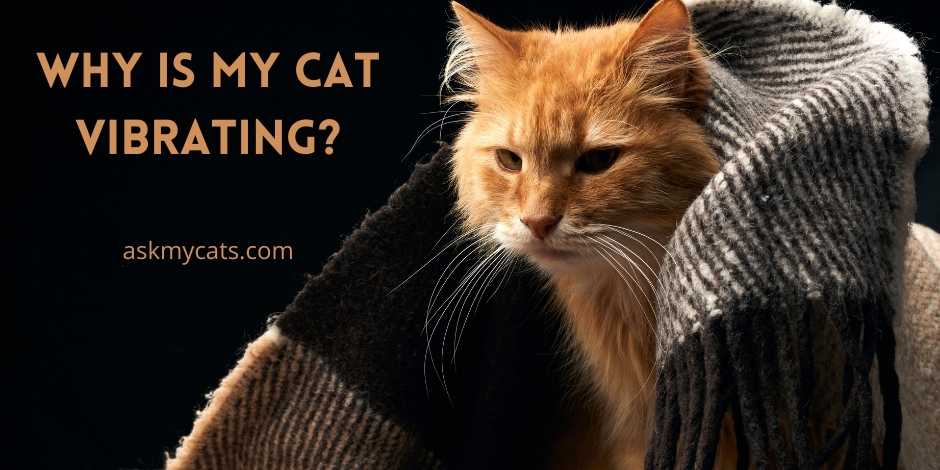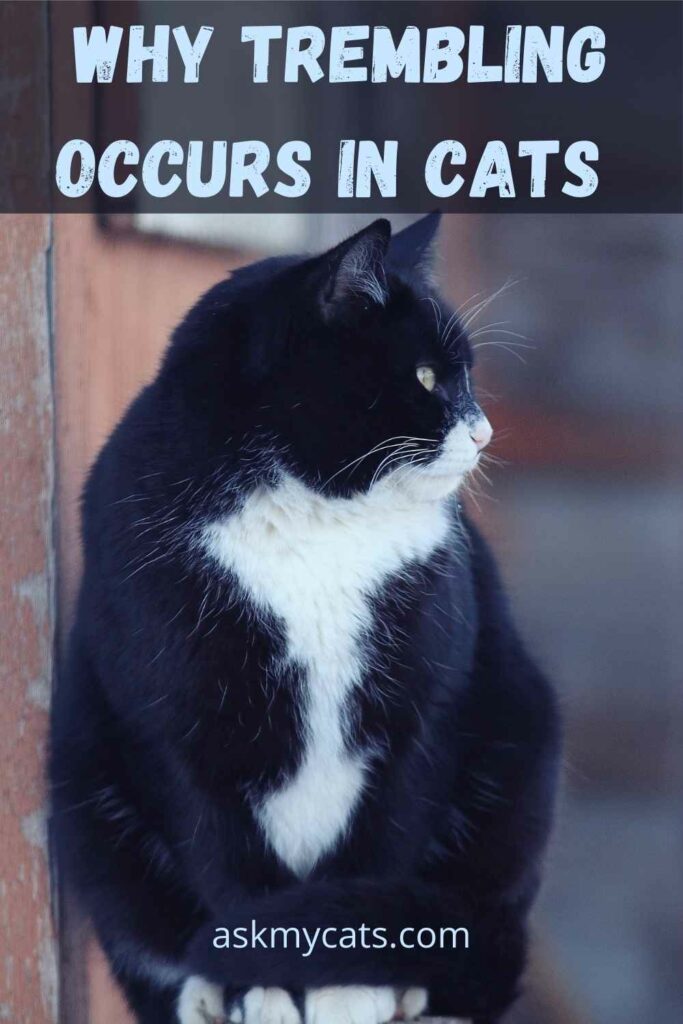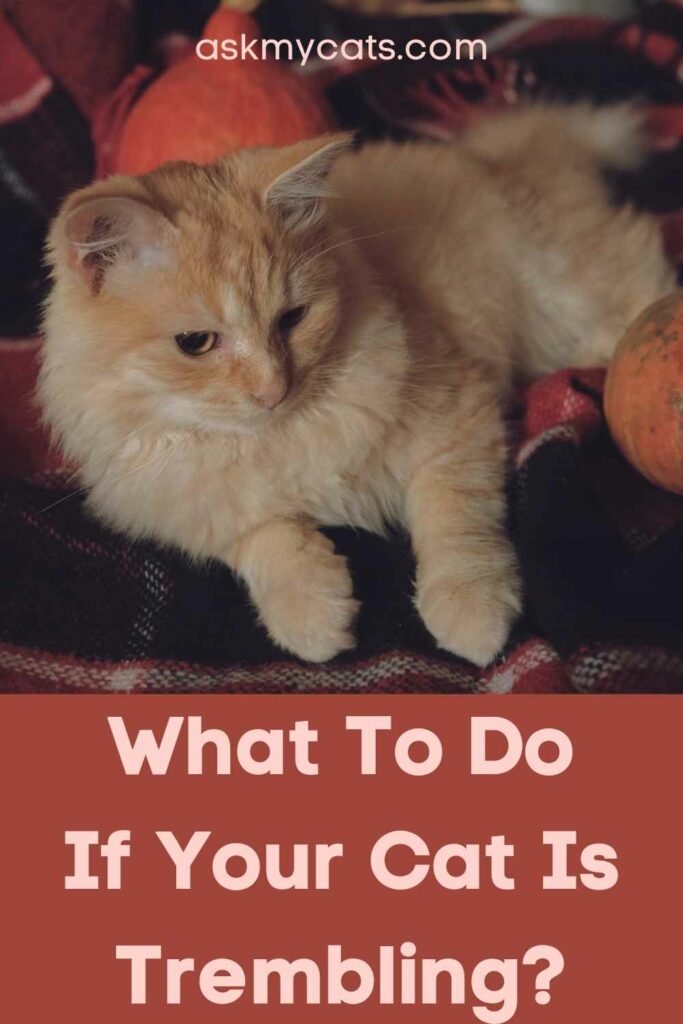Have you been noticing trembling in your feline and not certain what the reason is?
While it is normal to see your cat vibrates as he or she dreams while sleeping, and you may see them shake their head occasionally with nothing to worry about.
However, things get serious when you start to notice seizure-like movements that can be terrifying for both you and your feline.
You may see that your feline’s movements are unusual when your feline shakes his head, legs, or whole-body wildly.
There are a few conditions that could make your feline have compulsory, seizure-like movements:
- Harmfulness
- Hypoglycemia
- Kidney disease or kidney failure
- Hypothermia/hyperthermia
- Psychological issues
- Pain
- Shock
- Toxicity
In this article, we will answer all your questions and concerns. So, hold tight for some cat-trembling reading.


Give Your Cat the Perfect Day
Get the Free Ebook!
Why Trembling Occurs in Cats?
Trembling in cats can be due to many reasons.
Some reasons being normal and some being harmful. If you see your cat shaking when it is sleeping and probably dreaming about yummy cat food – it’s normal and you have nothing to worry about.
But if your cat starts to show signs of excessive trembling that in no way looks normal or healthy, you need to be alert.
In the first place, ensure that your feline has not been presented with any toxin that may be causing the seizure. Also, make sure to see a veterinarian right away.
Now there are various reasons why your cat is having abnormal trembling – so let’s discuss all of them one by one.

1. Hypoglycemia
If your feline has not eaten for a long time, her glucose can drop, bringing about hypoglycemia.
However, this condition can happen regardless of whether or not your feline eats constantly, and can be an indication of cat diabetes and should be treated by your veterinarian.
This is something more common in grown-up felines, yet can occur in cats most of the time. If your feline eats appropriately yet still encounters vibrating, see your veterinarian.
2. Kidney Disease
Kidney failure can make your feline experience seizures.
Loss of kidney work over the long run can cause a development of protein and side effects in the circulatory system, which can cause hunger misfortune, general discomfort and, if untreated, kidney failure.
3. Hypothermia
Felines with medical problems may likewise encounter hypothermia.
A feline’s typical internal heat level is somewhere in the range of 100.5 and 102.5, which most sound grown-up felines experience no difficulty keeping up with. Cats, particularly infants, can’t keep up with their own internal heat levels.
Utilize a warmed cover or warming cushion to empower warmth while you contact your veterinarian.
Causes Of Hyperthermia
Hyperthermia can be brought about by some intense issues: uncontrolled fever, excessive pain, and epilepsy. Felines are considered to have a fever any time their internal heat level transcends 103.5.
Frequently an infection or basic contamination can be the reason for the high fever and should be treated by a veterinarian.
The causes of hyperthermia are as follows:
1. Mental Issues
Your feline might be encountering a fear, social issues with another pet, or uneasiness and stress may likewise make your feline shudder.
2. Pain
A physical issue, tumors, and other inward ailments may make your feline shudder.
A veterinarian will be able to confirm that there are no basic issues that are making your feline shudder.
3. Shock
Shock or some major injury can lead to hyperthermia.
If your feline is shaking and has pale gums, cold appendages, and a fast pulse, see your veterinarian right away.
4. Toxic substances
Shockingly, your felines once in a while interact with harmful plants, synthetic substances, or other toxic materials.
If you speculate your feline has ingested something, is shaking, and perhaps retching, see your veterinarian right away.
Also read about Cat Shaking After Giving Birth: Possible Reasons
What To Do If Your Cat Is Trembling?
If you believe that your feline may have low glucose (hypoglycemia) and the feline can’t eat all by herself, you may utilize a dropper to give her some nectar or maple sugar; this will rapidly make her glucose levels rise up.

Also, if you notice hypoglycemia happening consistently, you need to take your feline in for some blood tests.
You may also need to change your feline’s eating habits or feed her more than what it used to eat.
Hypothermia can be lethal in little cats or debilitated grown-up felines. Your vet should treat the fundamental reason for the hypothermia.
A warming cushion warmed cover, or a warmth light can be utilized to assist your feline with keeping up with appropriate internal heat levels until you can get her to a veterinarian.
Hyperthermia is frequently the aftereffect of fever because of an infection or contamination, which should be treated by your veterinarian. Shock, pain, and intake of toxic substances are frequent causes of abnormal trembling.
Stress can adobe a reason and something that you should look into is the cause of the uneasiness in your feline and keeping her from overexertion and overstimulation.
Blood tests can decide whether your feline has a kidney infection and assist with deciding the best type of treatment for your feline.
Also, you would like to read about Newborn Kitten Twitching: Is It Normal For Newborn Kittens To Twitch?
How To Prevent Trembling In Cats
Hypoglycemia can be prevented by ensuring that your feline eats appropriate dinners consistently.
Also, keep harmful plants, like poinsettias, and synthetic compounds away from your felines. If your feline experiences tension, you should look for the cause of it and work on it accordingly.
An organ infection, for example, of the kidneys isn’t generally preventable.
Ensure new food and water are consistently accessible and a yearly well being check will incorporate blood tests that may uncover markers demonstrative of an organ issue so any infection can be gotten early when it is possibly treatable.
Cost of Treating The Trembling In Your Cats
If your feline is diagnosed to be hypoglycemic or diabetic, the treatment may cost you anywhere between $500-$2500 with continuous expenses. Insulin and different drugs can cost a normal of $50 to $200 each month.
The expense of treating a trembling feline relies upon the treatment required.
Why Do Cats Vibrate While Sleeping?
Just like us humans, cats dream and some even sleep talk. Chances are that your feline is vibrating and murmuring because they’re dreaming about that delicious cat food bowl or even milk.
Vibrations and murmurs are not always serious and you can easily know when you should be concerned.
Felines have various kinds of murmurs, which they transmit depending on the circumstance. Purring can be utilized to impart a requirement for a guardian. Those kinds of murmurs are called requesting murmurs, and are absolutely normal.
Why Is My Cat Vibrating After A Shower?
Your cat is vibrating after a shower because they might be feeling cold.

Exactly the same thing can occur if your feline gets trapped in the rainfall or snowfall. Like any of us, felines can shudder when they feel cold. It is an automatic response where the muscles shift back and forth among tightening and relaxing.
Generally, vibrating is simply the body’s method of heating up, particularly in a cool climate.
Vibrating starts when the surrounding temperature drops to a level lower than the body’s.
Ordinarily, a feline’s typical internal heat level will drift somewhere in the range of 100.5 and 102.5 Fahrenheit.
By vibrating, individuals and creatures gather heat in their bodies by as much as 500%. Nonetheless, the body can just shudder and warm itself for just a specific period.
In your newly bathed feline, his vibrating can be stopped by draping them in a towel right away and drying them out.
What To Do If Your Cat Is Vibrating After A Shower?
Regardless of whether you have utilized warm water in washing your cat, the leftover water on his fur can cause him to feel cool, regardless of whether the temperature is generally warm.
To prevent your feline from vibrating after shower, you should get him dry as fast as you can. You can drape him with a towel and afterward move him to a hotter region in your home.
In case he isn’t anxious about the sound of a hairdryer, you can utilize one to dry his fur quicker.
A few felines can shudder and inhale intensely after a shower. In such cases your feline is showing you how much they hated that shower.
In this situation, the thing that you need to do instead of drying your feline is to quiet him down. The most ideal approach to do that is to take him in a warm and dim region in your home.
Leave your feline inside the space for about thirty minutes, letting him and his breathing rate at regular intervals.
If things don’t return to normal after 30 minutes, go to the veterinarian right away.
Frequently Asked Questions
How would it be advisable for me to respond if my feline is shaking?
If you notice your feline is still shaking and not eating as expected, it is advised that you must call your vet. Your vet will probably do a few blood tests, which can give answers.
For what reason do felines murmur when they are biting the dust?
While kicking the bucket felines may show their satisfaction through purring, they may likewise murmur as a method for dealing with stress – purring has been displayed to fortify the feline’s muscles, and may even deliver endorphins that assist her arrangement with whatever pain she’s going through.
For what reason does my feline sound like an engine?
The most well-known explanation concerning why your feline sounds like an engine now and then is because they murmur. At the point when they murmur it is generally a sign that they are cheerful or satisfied. If they murmur and rub against you this implies they are satisfied with your organization and it is their method of showing their love towards you.
What does a feline seizure resemble?
The legs may move in a rowing style like your feline is attempting to swim, or they may become unbending and straight. Your feline’s mouth may likewise open and close automatically. Its head may curve back, it might begin moving on the floor until it reaches a stopping point, and it might even pee or crap during a seizure.
Is it typical for a feline to shake while purring?
In this way, as should be obvious, there are numerous reasons for shaking and additionally vibrating in felines. What’s more, once more, the shaking can be only their head, feet, tailor the entire body, and it can happen while snoozingor when being petted and purring.
What should I do if my cat has a seizure?
If you notice your cat having a seizure but it stops after one to two minutes, then you should call your vet and make an appointment to have your cat seen as soon as possible. If they are short but back-to-back, or they have more than one, you should take your cat to the veterinarian immediately.
Why is my cat suddenly having seizures?
The most common cause of a seizure in a cat is toxin exposure. Flea and tick medication, sprays, dips, and shampoos can contain a chemical called pyrethrin that can cause a cat to have a seizure
What are the symptoms of a cat having a seizure?
Typical symptoms of a cat’s seizure include a sudden collapse, loss of awareness, violent shaking of all four limbs, chewing and/or twitching of the face,and often salivation, urination and defecation.
Are cat seizures fatal?
Your cat will lose all muscle control. Limbs will jerk intensely and it will lose control of its bladder and bowels. These seizures last for 1-3 minutes. So yes seizures can be potentially fatal.
Can a cat recover from a seizure?
Most seizures will stop on their own within one to three minutes, although it may take a few minutes to a few hours for the cat to completely recover.Final Words
Final Words
Seeing your feline shaking is disturbing for any pet parent and shouldn’t be disregarded. If your feline has abruptly begun shaking, the first thing you must do is address your veterinarian.
They will talk through your feline’s symptoms with you and give consolation about what to do straightaway. They can likewise choose if your feline necessities veterinary consideration desperately.
Your feline might be shaking everywhere or simply aspects of their body like their ears, head, paws, or tail. Shaking may likewise be depicted as jerking, quakes, seizures, or any strange development that seems compulsory.
If you can, take a video of your feline’s conduct as it is simpler for the vet to perceive what your feline is doing than for you to need to clarify it.
